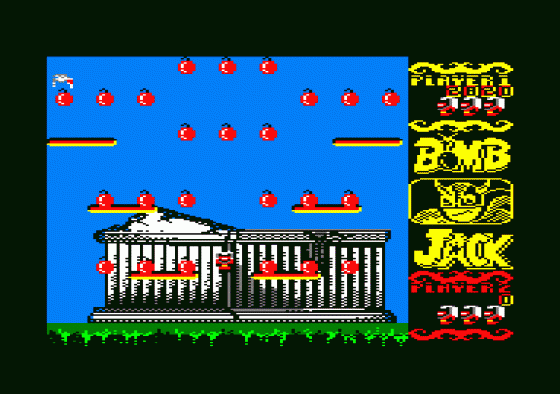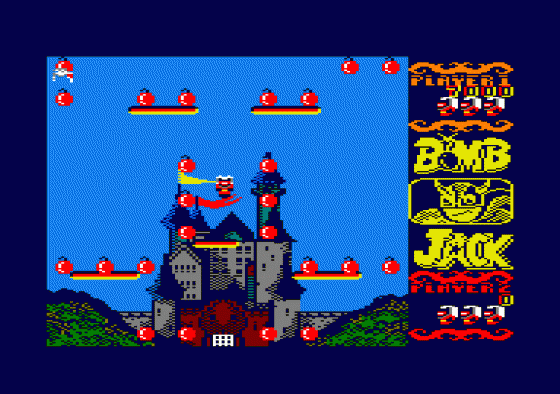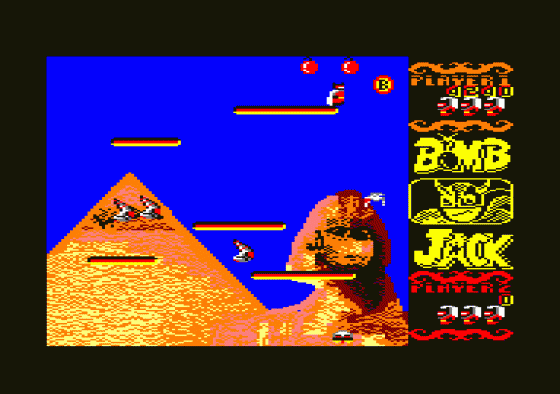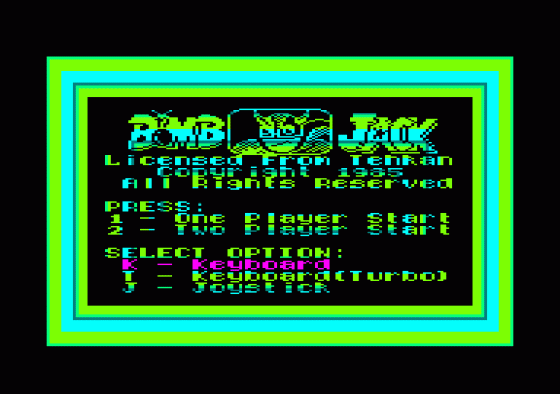
Amstrad Computer User
 1st July 1986
1st July 1986
Categories: Review: Software
Publisher: Elite
Machine: Amstrad CPC464
Published in Amstrad Computer User #20
Bomb Jack
Amusement machines usually have quite a short life, at least they do in London. In Southend old machines never die, they just move from arcade to arcade. A game which hangs about in The Smoke must be good, it. will only occupy the valuable floor space if it is earning its keep. Bomb Jack machines are still to be found in the West End so they must be popular and so Bomb Jack must be a good game.
What matters is how good a conversion the Amstrad game is. The good news is that Elite have done an excellent job. For those of you who haven't seen the arcade machine, you play the part of a little man, a sprite which looks all the world like the cartoon character Mighty Mouse. You have to walk around the screen collecting bombs and avoiding a weird collection of aliens.
Thinking about the game, Bomb Jack is a kind of Pacman with gravity. Your man falls to the bottom of the screen. You need to jump to get back up. You can hover by pounding the fire button in a sort of flapping action. This doesn't quite last long enough for you to get from one side of the screen to the other. You can control how high you jump by using the fire or jump button. Pressing once sends you skywards, pressing again stops you from going all the way to the top.

There is no attempt to get this game to make sense. The bombs don't even blow up. You have to collect all 23 bombs while dodging the nasties. There is no time limit, but as you play the number of aliens increases. To counter this some special bonuses appear. One is a flashing P, which freezes the baddies and allows you to kill them. I suppose that this is the Bomb Jack equivalent of the power pills in Pacman. Perhaps the P stands for "Pacu" the Japanese word for eat and is one of the reasons given for the name Pacman. The other theory is that the game was named after Alfred Packer, an American cannibal. But. all this is by the by. In addition to the Ps there are Bs which award you bonus points and Es which give you an extra man. These tumble around the screen at random intervals.
Part of the skill in Pacman was learning a pattern which guaranteed that you would clear the screen. The same is true of Bomb Jack but learning the pattern is made easier by the bombs sparking. The fuse on a new bomb starts to flash as you pick up the last sparking bomb. If you collect all the bombs in the sparking order you win a 50,000 point bonus. Missing one bomb merits 30,000 points and two bombs missed still gets you 20,000.
The simple game is made more interesting by a variety of backdrops. You start with a Sphinx and pyramid behind you, then a Germanic castle followed by a Japanese city and finally a field.

The scenes cycle as do the layouts for the bombs and platforms. The backdrop does not affect the game, it is the pattern of the bombs which matters. If the enthusiasm with which Bomb Jack was met in the Amstrad User office is mirrored in the software shops throughout the country then Elite should have another number l on their hands.
Liz
I eagerly awaited the arrival of Amstrad Bomb Jack, I'd been warming up on the Spectrum version. Despite the attribute clash on that machine I loved the game. Before our review copy arrived I had been warned that the Amstrad version was not as good, all the same I hopped about the office with excitement when it turned up in the post.
My initial reaction was disappointment. For a start, the program did not play the tunes that the arcade game produced. Among them Lady Madonna by the Beatles.

The sprites, particularly Bomb Jack himself were a bit ordinary and the joystick control was sluggish. This last problem was solved by trading in a very old Competition Pro for a Konix Speedking. Then I got hooked. If I failed to get the full bonus on the first screen I abandoned the game. This is the best yet from Elite.
Nigel
Great. Loved it. It didn't have boring bleeps which get on my nerves after 21 seconds, but just a few simple tones to let you know what's going on. As for the game itself. I found it both fun and addictive, with a slow increase in difficulty to keep things interesting. I also liked the way you can either play to get as many points as possible going for the bombs in order, or you can play for as many sheets as possible, just getting as many bombs as fast as possible.
Colin
Why has this game been so successful on other machines and is destined to become so on Amstrad? In a word - addictiveness. This is one of the first games that has really inspired an inter-office championship to see who could make the highest score.
The concept is ludicrously simple, just jump about a screen and get the 20 odd bombs before one of the baddies gets you. I don't think that the pretty backdrops on each screen really have much to do with it either.
Once you get the hang of it you soon start to learn the correct order to get the bombs for each screen, ensuring a large bonus on each. The highest score so far stands at about 350,000, though I'm sure there are bound to be those who will beat this easily.
Other Reviews Of Bomb Jack For The Amstrad CPC464
Bombjack (Elite)
A review by Bob Wade (Amstrad Action)
Bomb Jack (Elite)
A review
Bombjack (Elite)
A review





